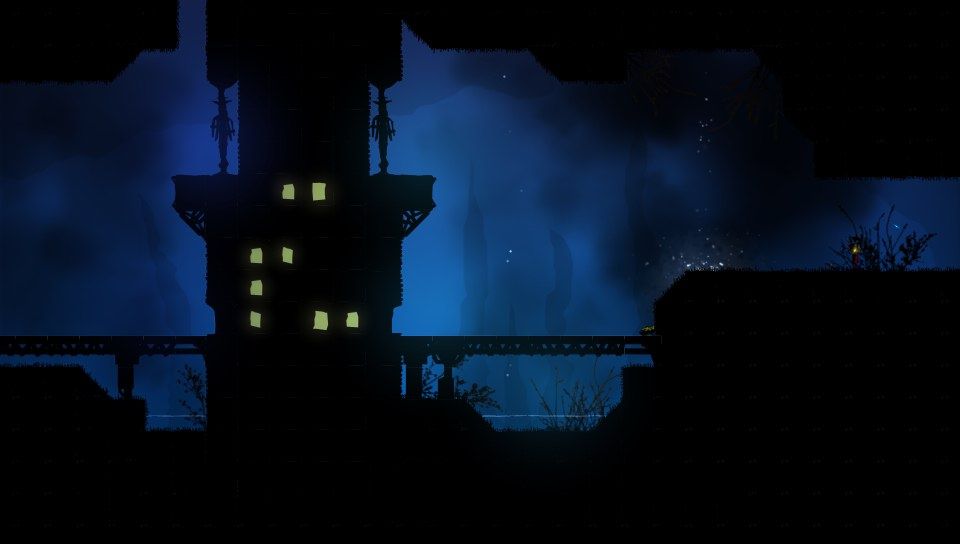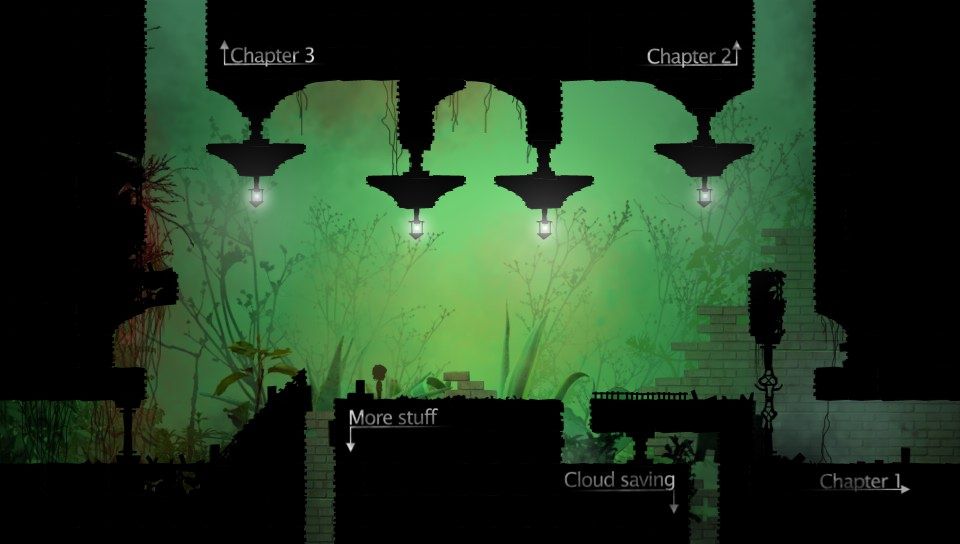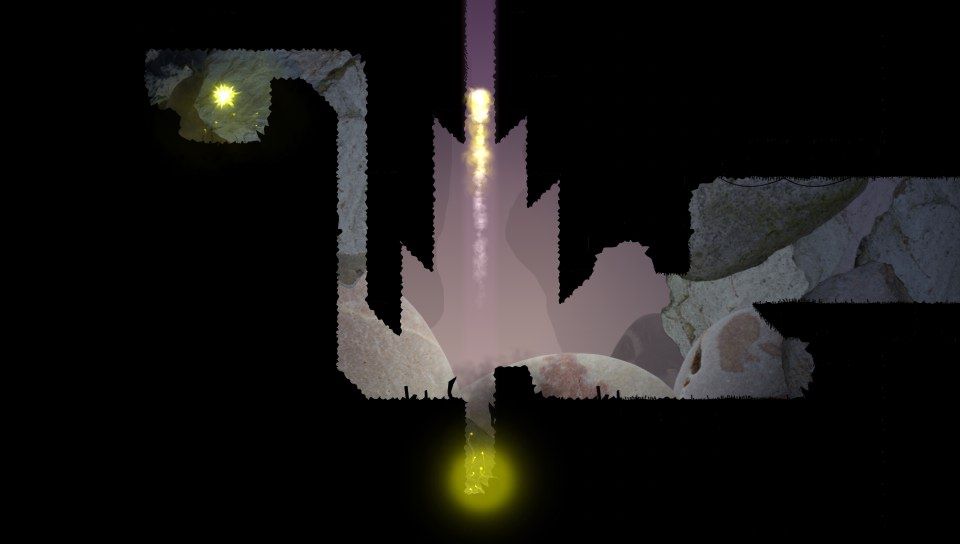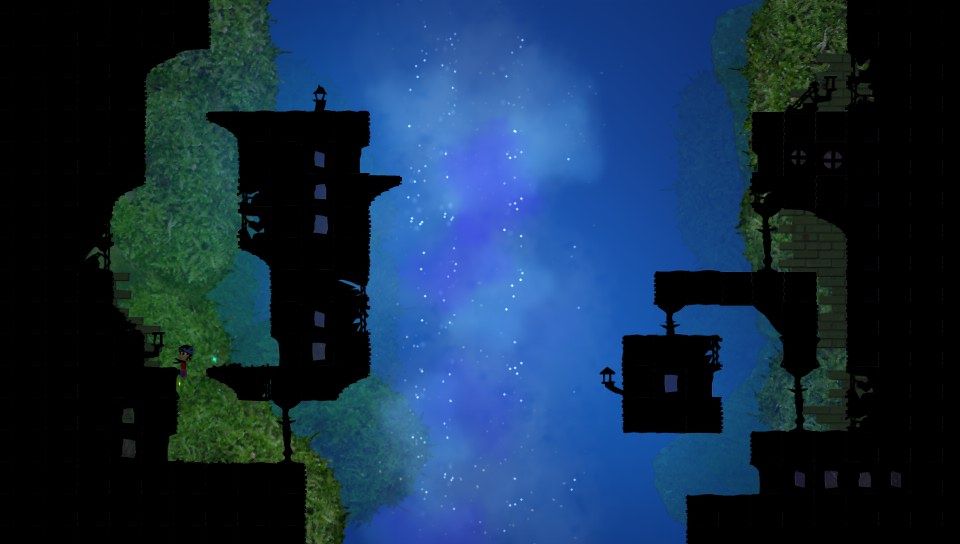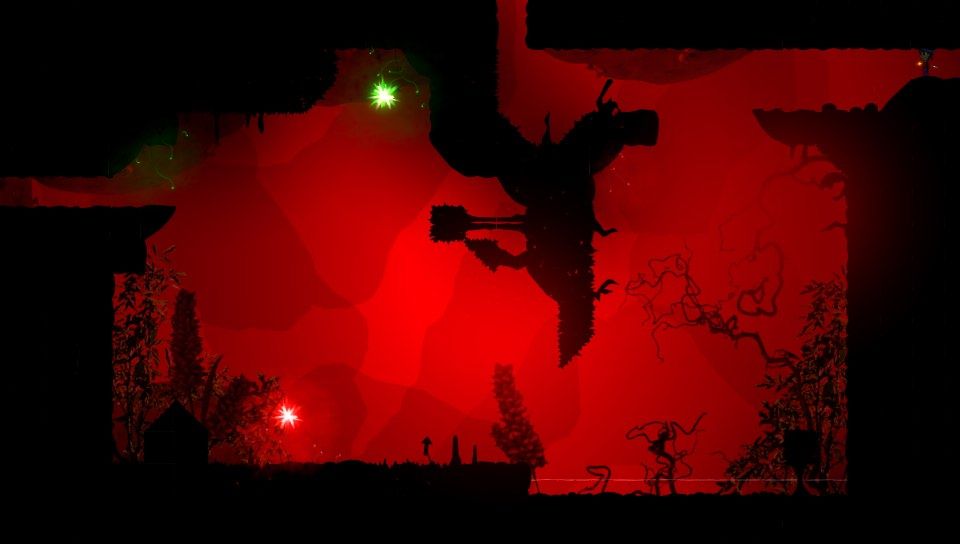I wasn't aware of the Knytt series of critically acclaimed freeware PC games until earlier this year, when I first learned Knytt Underground was coming to the PS Vita. With the Vita stereotyped as a handheld with little in variety, I was glad to hear that this series --known for its deep exploration and freedom of play--would be adding its newest brood to the struggling system. Half a year later, that is exactly what Nifflas (Swedish game developer Nicklas Nygren) delivers with Knytt Underground, a game that may not have much in the way of a plot, but has enough great platforming and literal depth to spare.
When first booting up Knytt Underground, players are taken through a tutorial that teaches the game's easy platforming and climbing controls. This then brings players to the Chapter Select screen, where Knytt Underground is split into three Chapters, not only to divide up the story, but to divide the way the game's protagonist, Mi, explores the world. Platforming and exploring in Underground is like most other games of its ilk, with some areas, or "rooms," that are inaccessible until certain items and quests are complete. But it's how Knytt Underground presents these areas that makes it stand out a little from the pack.
Knytt Underground takes places eons after the human race vanished, with fairies and other supernatural creatures left to try and figure out what came before them. Various human artifacts are sought after and traded, although no one knows the true value of them. This makes bartering difficult, since many citizens change how much an item is worth day to day (and minute to minute), and no one can agree if a silver coin is more valuable than a bronze one or a stone. There are many who try to figure out the past of the world they inhabit, one of which are the Myriadists, a religious group who believe everyone has a piece of the truth inside of them, and that if all of these "truths" were put together, the answers would be found. Their counter-group are the Internets, who piece together what disparate information they find to try and understand the world that came before. Finally, though they are few, there are explorers, spelunkers, and adventurers, like Mi, who just try to see as much of the world as they can. It's through one of Mi's typical adventures that the game's plot gets underway.
Without spoiling the game's unusual narrative and twists, Mi has her typical set of platforming skills available in the first chapter, which are occasionally expanded by glowing spheres of light. These spheres confer to Mi magical movement abilities for a limited time after she touches them: Red Spheres allow her to jump farther; Blue Spheres allow her to fly across a screen (or multiple screens) horizontally; Yellow Spheres allow her to fly up a screen (or multiple screens) vertically; and Green Spheres allow her to travel freely as she desires until the effect wears off. There are also White Spheres, which allow Mi to blast the strange Robotic enemies that populate certain rooms of the game, but don't expect to find many of these spheres in the game.
The second chapter drastically changes the mechanics of the game, and allow the player to get to some previously inaccessible places, but at the cost of limited access to rooms you could explore before. This part of the game offers new challenges in navigating the rooms and avoiding enemies, and while initially jarring, later becomes natural and intuitive.
The last chapter of the game will take up the majority of Knytt Underground's playtime, expanding Mi's purpose in the game's narrative, while giving players a wider range of mobility and the entire world to explore. There are still challenges to overcome, still enemies to avoid, but the game offers so many places to see that the sheer depth is enough to keep players busy for long periods of play.
This is where Knytt Underground becomes an amalgamation of its design influences, like the Zelda, Metroid, Castlevania, and Mario. Every challenge can be overcome by a mixture of platforming skills and the occasional Sphere (or two, or three). A lot of these won't be easy; expect to die often in certain rooms, where the only way to overcome a challenge is through trial and error, and experimentation. And often, if a room seems impossible to overcome at the time, coming to it later or finding a way around it is the better choice, since there are secret paths laid throughout the map that take players to previously insurmountable places.
The awe and wonder Knytt Underground creates is usually due to its beautiful backgrounds and music. The areas offered in Underground are sometimes surreal, sometimes terrifying, sometimes mysterious; each part of the subterranean worlds in Underground have their own visual aesthetic and challenges, with some rooms populated by more robotic enemies, some with more hazardous surfaces, some with shifting terrain, some with visibility changes, and some just with seemingly impossibly platforming sections. Often I would get lost on purpose, diving further and further down into the game, trying to get as far to the edge as possible to see what I could find. In a game like this where moving and climbing through similar rooms could become tedious fast (with earlier parts of the game offering a limited scope of what Underground truly offers), it's amazing that the breadth of Knytt Underground's world can have so much variety once players truly get out and see it.
Knytt Underground isn't without faults though. Where the game's exploration is deep and rich, the game's narrative offers little until later in the game. The story gives little more than a series of conversations between various newly introduced characters, who all enter and exit from the plot as fast as characters in a children's fairy tale. But it is worth noting that the Knytt series is partially based on Swedish folklore, and that the game's focus isn't meant to be a complicated or heart-wrenching plot the likes of Mass Effect 3 or Telltale's The Walking Dead. But what it does excel at is a sense of discovery, reverence, and curiosity, and it's clear that Nifflas' focus was on players playing for exploration's sake than plot. The plot is just a means to an end, a reason to give players to find specific rooms, and all the places along the way.
The game's platforming sections can also be a little difficult for the uninitiated platform gamer, with several areas requiring patience, repetition, and determination. Players who are fans of retro platforming games may appreciate these occasional challenges and puzzles, though: the sense of accomplishment that comes with making it past a difficult challenge and discovering a new room is rewarding in and of itself, and Underground offers plenty of special challenges like these.
Overall, Knytt Underground is a huge, wonderful game, one that offers a large, undiscovered world that comes with secret areas, new worlds, and enough rooms to keep players coming back for more. Knytt Underground may not be for everyone: anyone looking for a stronger story and more action won't find it here. For everyone else, this is a game truly worth your time, and fun to play at home, or on the go with the Vita. Try it out, get lost, and enjoy.
The Playstation version of Knytt Underground offers the "Cross-Play" feature, allowing players to share saves between their PS3 and Vitas, and the "Cross-Buy" feature, which allows them to buy it once and get it for both systems. Knytt Underground is not only a must-play for platforming fans, but a must-buy for owners of the PS3 and PS Vita.

